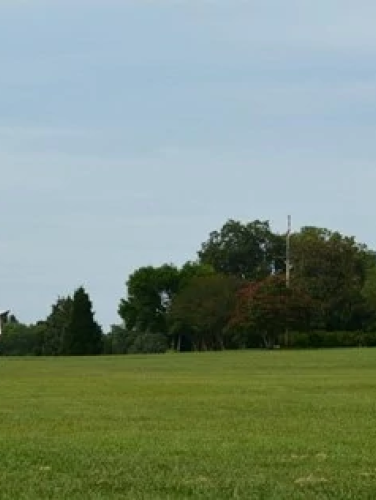
Rural Hill Plantation
(ca. 1788)
The family home of Revolutionary War Major John Davidson was destroyed by fire in 1886, leaving only traces of the grandest of the Catawba River plantation houses.
4431 Neck Rd, Huntersville, NC 28078
Rural Hill was the plantation house built on a promontory near the Catawba River in northwestern Mecklenburg County by Major John Davidson (1735-1837), a North Carolina militia officer in the Revolutionary War. The original mansion burned in 1886, although partial ruins do remain. The present house is an expansion and remodeling of the original kitchen.
Property Quick Links
Davidson was born on December 15, 1735, in Lancaster County, Pennsylvania, the son of Scottish immigrants Robert (1713-1740) and Isabella Ramsey (1715-1782) Davidson. Following Robert’s death at the age of 27, Isabella moved to Rowan County with John and daughter Mary in the mid-1700s, where she married Henry Hendry, the children’s tutor. John became a blacksmith and moved to the Hopewell Church section of Mecklenburg County in about 1760. In 1761, he married nineteen-year-old Violet Wilson (1742-1818), the second daughter of Catawba River plantation owner Samuel Wilson. The newlyweds got their start in a two-room log cabin on land given by Violet’s father. The house, later known as Rural Retreat, grew to eight rooms before it was lost in an 1898 fire.
In addition to farming the land, John was an active participant in civic affairs. In addition to serving in the county militia, he became one of Mecklenburg's two delegates to the colonial North Carolina Assembly in New Bern in 1773 and a member of the Mecklenburg Committee of Safety that purportedly led to him becoming a signer of the Mecklenburg Declaration of Independence. When war broke out, John received his first state militia commission from the state’s provincial congress in September 1775. After three field campaigns, John became a staff officer of the Salisbury Brigade, and was present at Cornwallis' defeat of the American forces at Camden, South Carolina in 1780.
When the war ended, John returned to the life of a prospering country squire, acquiring nearly five thousand acres of land. In 1788, he began construction of a fine two-story mansion just south of his Rural Retreat. Constructed of brick made nearby, the Georgian-style house was the grandest of the Catawba River plantation houses and the center of the Davidson and extended families for many years. The surrounding property contained numerous outbuildings, including a well house, ash house (to make lye for soap), summer kitchen, carriage house, smoke house, barns, stables, and pens. Also nearby were cabins for the enslaved persons that John used to maintain his agricultural operations. By 1790, he owned at least twenty-six enslaved persons, making him one of the county’s largest slaveowners. When the 1793 invention of the cotton gin made cotton cultivation more profitable, John substantially increased his use of enslaved labor.
In 1823, at the age of 88, John decided to retire. As Violet had died five years earlier, John appointed his son-in-law William Lee Davidson (the son of the Revolutionary War general) as his trustee to dispose of all his personal and real property. John spent the remainder of his days living with William Lee and John’s daughter Betsy at their nearby plantation Beaver Dam. In 1886, while owned by John’s grandson Adam Brevard Davidson, the mansion house burned while the family was away.

